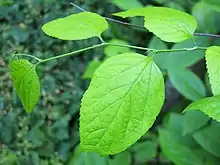Celtis caucasica
Celtis caucasica, the Caucasian hackberry or Caucasian nettle tree, is a species of flowering plant in the family Cannabaceae.[2][3] It is native to the Caucasus region, Central Asia, and on to the western Himalaya.[1] Hardy to USDA zone 5b, it tolerates poor soils, drought, and nearby paving, and can be used as street tree.[4][5] It is a nitrogen-fixer, in symbiosis with the mycorrhizal fungi Funneliformis mosseae and Rhizophagus intraradices.[3]
| Celtis caucasica | |
|---|---|
 | |
| Foliage | |
| Scientific classification | |
| Kingdom: | Plantae |
| Clade: | Tracheophytes |
| Clade: | Angiosperms |
| Clade: | Eudicots |
| Clade: | Rosids |
| Order: | Rosales |
| Family: | Cannabaceae |
| Genus: | Celtis |
| Species: | C. caucasica |
| Binomial name | |
| Celtis caucasica | |
| Synonyms[1] | |
| |
References
- "Celtis caucasica Willd". Plants of the World Online. Board of Trustees of the Royal Botanic Gardens, Kew. Retrieved 19 October 2021.
- "Celtis caucasica Caucasian nettle tree". The Royal Horticultural Society. 2021. Retrieved 19 October 2021.
- Sepahvand, Tooba; Etemad, Vahid; Matinizade, Mohammad; Shirvany, Anoshirvan (2021). "Symbiosis of AMF with growth modulation and antioxidant capacity of Caucasian Hackberry (Celtis caucasica L.) seedlings under drought stress". Central Asian Journal of Environmental Science and Technology Innovation. 2 (1). doi:10.22034/CAJESTI.2021.01.03.
- "Celtis caucasica". vdberk.co.uk. Van den Berk Nurseries. Retrieved 19 October 2021.
- "Celtis caucasica Caucasian Nettle Tree". Chicago Botanic Garden. Forest Preserve District of Cook County. 2021. Retrieved 19 October 2021.
This article is issued from Wikipedia. The text is licensed under Creative Commons - Attribution - Sharealike. Additional terms may apply for the media files.